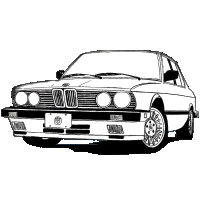Engines
The E28 was the first 5 Series produced with diesel engines (the 524d and 524td models) and with a petrol engined model specifically aimed at increased fuel economy (525e/528e model).
The four models available at the launch of the E28 were the 518, 520i, 525i and 528i,<ref>BMW: 518 520i 525i 528i. February 1982</ref> with the 518 using a straight-four petrol engine and the other three models using a straight-six petrol engine. Over the course of the E28 model, the following models were added: the 524d and 524td using diesel engines, the 518i (a fuel-injected version of the 518), the 525e/528e as fuel-economy models, and the upper-specification 533i, 535i, M535i, and M5 models.
A liquid petroleum gas (LPG) option was introduced for some petrol engines in 1984.<ref>Template:Cite web</ref>
Petrol
518: Sold only in some European markets where it suited local tax categories, the 518 was the lowest specification model which used a four-cylinder engine with a carburetor. Factory performance figures for the manual transmission cars are a top speed of Template:Convert and 0–100 km/h acceleration in 14.0 seconds.<ref name="E28_518">518, 520i, 525i, 528i. Pages 6 and 50</ref>
518i: The base model in Japan and some European countries, the 518i used a fuel-injected four-cylinder engine. Factory performance figures for the manual transmission cars are a top speed of Template:Convert and 0–100 km/h acceleration in 12.6 seconds.<ref name="BMW-E28-Betriebsanleitung" /> This version was not sold in West Germany until the 1984 facelift, when it replaced the carburetted 518.
520i: A mid-range model with the smallest of the available six-cylinder engines. Factory performance figures for the manual transmission cars are a top speed of Template:Convert and 0–100 km/h acceleration in 11.4 seconds.<ref name="BMW-E28-Betriebsanleitung" />
525e / 528e: The 525e (called 528e in North America and Japan) uses a longer stroke 2.7-litre version of the 6-cylinder M20 petrol engine, is optimised for fuel economy and torque at low engine speed rather than the traditional high revving characteristics of BMW straight-six engines.<ref>Template:Cite web</ref> The "e" stands for the Greek letter eta, for economy. According to BMW, the 525e is more fuel efficient than the 520i, which has the same rated power of 92 kW.<ref>BMW: 525e 525e Katalysator. 1985</ref> Since many markets tax cars based on engine displacement, the eta's larger engine meant that it was not suitable everywhere. The model was expressly developed with the American market in mind. BMW's corporate average fuel economy was at risk of not meeting requirements by 1984, primarily due to higher sales of their bigger, more expensive cars in the early 1980s.<ref name=AG941>Template:Cite magazine</ref> In Austria, the 525e was detuned to Template:Convert.
Factory performance figures for the manual transmission cars without a catalytic converter are a top speed of Template:Convert and 0–100 km/h acceleration in 10.7 seconds. With a catalytic converter, the figures are a top speed of Template:Convert and 0–100 km/h acceleration in 11.3 seconds<ref name="BMW-E28-Betriebsanleitung" />
525i: This mid-range model is powered by a 2.5-litre 6-cylinder engine. The 525i was only sold in Europe. Factory performance figures for the manual transmission cars are a top speed of Template:Convert and 0–100 km/h acceleration in 9.8 seconds.<ref name="BMW-E28-Betriebsanleitung" />
528i: Initially the highest specification available, the 6-cylinder 528i became a mid-range model following the release of the 533i and 535i models. Factory performance figures for the manual transmission cars are a top speed of Template:Convert and 0–100 km/h acceleration in 8.4 seconds.<ref name="BMW-E28-Betriebsanleitung" />
533i: Only sold in Japan and North America,<ref>Template:Cite web</ref><ref>Template:Cite web</ref> the 6-cylinder 533i was the highest specification model during its production years of 1983–1984. It was replaced by the 535i.
535i/is: Released in 1984, the 535i replaced the 533i and uses the same 6-cylinder drivetrain as the M535i. In the US there was also a 535is model, which included sport seats and spoilers at the front and rear. Factory performance figures for the manual transmission cars without a catalytic converter are a top speed of Template:Convert and 0–100 km/h acceleration in 7.2 seconds. With a catalytic converter, the figures are a top speed of Template:Convert and 0–100 km/h acceleration in 7.9 seconds<ref name="BMW-E28-Betriebsanleitung" />
M535i: The top of the regular production model range, the M535i uses the drivetrain from the 535i plus M-Technic suspension, and wheels and body panels not found on any other E28. The M535i was assembled on the standard E28 assembly lines in Dingolfing and Rosslyn. Factory performance figures for the manual transmission cars without a catalytic converter are a top speed of Template:Convert and 0–100 km/h acceleration in 7.2 seconds. With a catalytic converter, the figures are a top speed of Template:Convert and 0–100 km/h acceleration in 7.9 seconds<ref name="BMW-E28-Betriebsanleitung" /> Template:Clear right
Diesel
| Model | Engine | Power | Torque | Aspiration | Years |
|---|---|---|---|---|---|
| 524d | 2.4 L M21 straight-6 |
Template:Cvt at 4600 rpm |
Template:Cvt at 2500 rpm |
naturally aspirated |
1985–1987 |
| 524td | Template:Cvt at 4800 rpm |
Template:Cvt at 2400 rpm |
turbocharged | 1983–1988 |
524d: At the 1986 Geneva Motor Show, four years after the introduction of the more powerful 524td model, the naturally-aspirated 524d model was introduced.<ref name="AR87">Template:Cite book</ref>Template:Rp It was only sold in some markets.<ref name="AR87" />Template:Rp
524td: This turbodiesel model was the first diesel car produced by BMW. It entered production in late 1982, when 100 pre-series cars were built.<ref name="AK84">Template:Cite book</ref> Factory performance figures for the manual transmission cars are a top speed of Template:Convert and 0–100 km/h acceleration in 12.9 seconds.<ref name="BMW-E28-Betriebsanleitung" />

